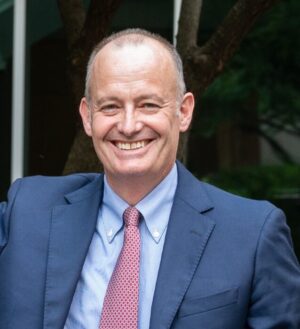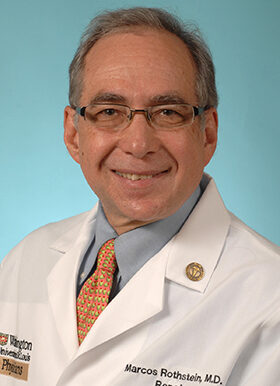For almost 80 years, dialysis has been a lifesaving procedure for patients with kidney failure, yet problems such as low quality of life and the realization that patients will have to remain on dialysis for the rest of their lives have resulted in an increased interest in kidney transplantation. The number of available transplantable kidneys, however, falls far short of the number needed.
Every day, 13 patients die waiting for a life-saving kidney transplant, yet approximately 2500 potentially transplantable kidneys are discarded every year – enough to transplant 7 patients per day.
The challenge is how to reduce the discard rate of kidneys in order to increase the rate of kidney transplants.

Benjamin Humphreys, MD, PhD, Joseph Friedman Professor of Renal Diseases in Medicine and Chief, Division of Nephrology, and Marcos Rothstein, MD, Professor of Medicine, Nephrology, are attacking that problem on multiple fronts.
Dr. Humphreys is trying to reduce discard rates by applying new technologies that allow the rapid testing of kidneys marked for discard and identify those that will function well if transplanted. He says that new technologies, such as single-cell RNA sequencing, allow researchers to look at old problems in new ways. “The new technology measures RNA to understand which kidney could be transplantable. It measures thousands of genes in one cell, instead of measuring one gene from a mixture of thousands of cells, the common technique used in the past.” The goal is to find markers that will predict the probability of failure and success of donated kidneys.
Humphreys’ current study involves performing a biopsy of a donor kidney at the time of transplant, at 1 month post-transplant, and again at one year post-transplant. Single-cell RNA analysis will then be used to identify the markers that are common to the successful transplants and the markers that are common to kidneys that are not successful (i.e. require dialysis after transplantation).
The study was discussed by Humphreys at the latest Foundation for Barnes-Jewish Hospital’s Leading Edge Medicine lecture series August 12, 2022 (watch the presentation here, or see below). The lecture series offers the opportunity for Foundation donors to meet and hear firsthand about the most recent advances in research and patient care.
“It was a lot of fun for me to speak directly to a general audience about the opportunities we have to improve the lives of patients with kidney failure,” says Humphreys.
Pilot funding granted to Humphreys by the Foundation for Barnes-Jewish Hospital helped obtain data that led to him receiving a Chan-Zuckerberg grant to study all the cells of the kidney as part of the Human Cell Atlas program, and ultimately enabled Humphreys and his team to tackle the current study.
“I am grateful to the Chan Zuckerberg Initiative for supporting our early-stage work to generate a single cell atlas of human kidney. Our team hopes to leverage this work to increase the number of kidneys available for transplantation.”
Learn more about Humphreys’ research on the Humphreys lab website.

Dr. Rothstein is approaching the challenge of increasing the pool of transplantable kidneys by keeping kidneys in good working order in potential donors who are declared brain-dead.
Over the last five years, the cause of death of deceased organ donors has changed, with trauma and stroke remaining stable, but anoxia increasing from 38% to 47% nationally. This anoxic brain death leads to acute kidney injury (AKI) in deceased organ donors.
The management of an organ donor with oligoanuric AKI (a condition, lying between anuria and oligouria, in which less than 100ml of urine is produced per day) is often curtailed due to hemodynamic and electrolyte instability. Although dialysis or continuous renal replacement therapy (CRRT) is a standard of care for severe AKI in critical patients, it is rarely started after the diagnosis of brain death in potential organ donors.
“The number of potential brain-dead donors with severe AKI, continues to rise across the country,” says Rothstein. “These subjects present a unique challenge. Mounting complications such as severe fluid overload and major acid-base and electrolyte disturbances cause increased instability forcing surgeons to expedite procurement, which limits the number of organs transplanted.”
Since 2017, the organ recovery center (ORC) at WashU/Barnes-Jewish Hospital has been initiating CRRT in organ donors with oligoanuric AKI to allow more time to stabilize the donor and improve the function of organs.
In a recent publication in the journal Clinical Transplantation, Rothstein and colleagues from the Department of Medicine at WashU and Mid-America Transplant, St. Louis, report the feasibility and beneficial usage of CRRT in 27 donors with oligoanuric AKI and diagnosis of brain death. Comparing the donors with oligoanuric AKI, the total number of organs transplanted per donor from this CRRT cohort was greater than the historical cohort that did not receive CRRT.
This is the first study at an independent ORC to describe in detail the process of starting CRRT in deceased donors after the diagnosis of brain death, which was associated with more organs being transplanted. It is hoped that these results will lead to protocols resulting in a larger pool of transplantable kidneys.
“We have demonstrated that performing CRRT on brain-dead donors can be accomplished in a practical and cost-efficient manner,” says Rothstein. “This resulted in an increased number of procured organs which otherwise would have been discarded. We suggest that other ORCs replicate and corroborate our findings by extending CRRT in organ donors with oligoanuric AKI as another fundamental tool in their successful management.”
Read the article “The Benefits of Initiating CRRT after Brain Death in Organ Donors with Oligoanuric Acute Kidney Injury” here. Authors: Gary F. Marklin, Laura Ewald, W. Dean Klinkenberg, Christina M. Joy, Steven J. Bander, and Marcos Rothstein.
On Twitter, follow @HumphreysLab, @NephroMaven (Rothstein), @JoyMariyam, and @midamtransplant; keep updated with the Division of Nephrology @WUNephrology. Follow the Foundation for Barnes-Jewish Hospital and WashU Nephrology on Facebook.
Watch Dr. Humphreys discuss organ donation for the Foundation for Barnes-Jewish Hospital’s Leading Edge Medicine lecture series.